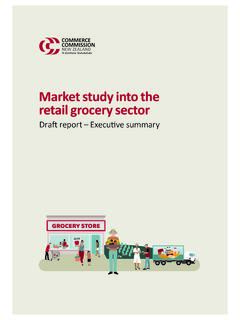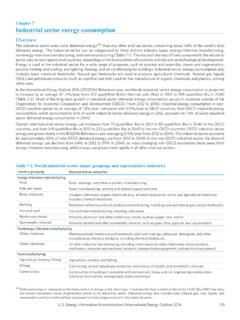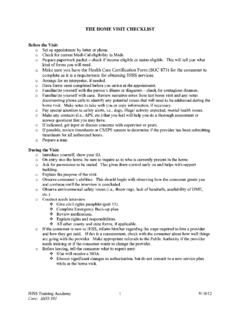Transcription of Youth and agriculture
1 Youth and agriculture :key challenges and concrete solutionsYouth and agriculture :Key challenges and concrete solutionsPublished by the food and agriculture Organization of the United Nations (FAO) in collaboration with the Technical Centre for Agricultural and Rural Cooperation (CTA) and the International Fund for Agricultural Development (IFAD)iiThe designations employed and the presentation of material in this publication do not imply theexpression of any opinion whatsoever on the part of the food and agriculture Organization ofthe United Nations (FAO) ), the Technical Centre for Agricultural and Rural Cooperation (CTA) orthe International Fund for Agricultural Development (IFAD) concerning the legal or developmentstatus of any country, territory, city or area or of its authorities, or concerning the delimitationof its frontiers or boundaries. The mention of specific companies or products of manufacturers,whether or not these have been patented, does not imply that these have been endorsed orrecommended by FAO, CTA or IFAD in preference to others of a similar nature that are notmentioned.
2 The views expressed herein are those of the authors and do not necessarily representthose of FAO, CTA or publication contains opinions of and statements by various information providers. FAO, IFADand CTA do not represent or endorse the accuracy or reliability of any opinion, statement or otherinformation provided by any information publication contains links and references to third-party Web sites. The linked sites are notunder the control of FAO, IFAD and CTA and FAO, IFAD and CTA are not responsible for thecontent of any linked site.(FAO) ISBN 978-92-5-108475-5(FAO) E-ISBN 978-92-5-108476-2 (PDF)(CTA) ISBN 978-92-9081-558-7 FAO, 2014 FAO encourages the use, reproduction and dissemination of material in this information product. Except where otherwise indicated, material may be copied, downloaded and printed for private study, research and teaching purposes, or for use in non-commercial products or services, provided that appropriate acknowledgement of FAO as the source and copyright holder is given and that the FAO s endorsement of users views, products or services is not implied in any requests for translation and adaptation rights, and for resale and other commercial use rightsshould be made via or addressed to information products are available on the FAO website ( ) and canbe purchased through photo: IFAD/Susan BeccioThe resources used by FAO for this document have been provided by the Swedish International Development Cooperation Agency (Sida).
3 Sida does not necessarily share the views expressed in this material. Responsibility for its content rests entirely with the vAcknowledgments viiExecutive summary ixAcronyms xiIntroduction xvii1. Access to knowledge, information and education Introduction Case studies 41. Agri-enterprise development and management 42. Rebranding agriculture in schools 53. Young Women Open Schools 64. On-the-job training 75. PhD training in agriculture 96. Distance learning for young farmers 107. ICTs for extension services 118. ICT solutions for agriculture 139. Youth resource centres on agriculture Conclusions 162. Access to land Introduction Case studies 2110. Land tenure, farm productivity and enterprise development 2111. Land ownership for shea butter producers 2312. Distributing hillside land to landless Youth 2413. Young rural entrepreneur and land fund programme 2414. Reclaiming desert land for young graduates 2615. Small landlords and large tenants programme 2816.
4 Short-term land leases for Youth Conclusions 303. Access to financial services Introduction Case studies 3517. Installation aid 3518. Public-private investment fund 3719. Youth Venture Capital Fund 3820. Youth socio-economic empowerment service 3821. Financial services for Youth through rural entrepreneurship 3922. Friends Help Friends Saving Group 4023. Loan project for young entrepreneurs 4224. Crowd-funding: The goat dairy project 4325. Finance and mentorship for innovative young social entrepreneurs Conclusions 45iv4. Access to green jobs Introduction Case studies 5126. Junior Farmer Field and Life School programme 5127. Vocational training in small biogas companies 5228. Vocational training for young beekeepers 5329. Green jobs apprenticeship programme 5430. Raising Youth s awareness of organic agriculture 5531. Agro-ecotourism business 5732. Transforming water hyacinth into paper Conclusions 605. Access to markets Introduction Case studies 6533.
5 Connecting farmers 6634. Innovation in distribution and sales 6635. Linking producers and consumers 6836. Certifying social Youth business 6937. Milk and dairy processing 7038. Innovative models for young coffee producers 7139. Independent business born from the commitment of Youth Conclusions 736. Engagement in policy dialogue Introduction Case studies 7940. Young farmers representation 7941. The African Union listening to Youth 8142. Documenting Youth policies and initiatives 8243. Youth peasant federation 8444. Echoing the voices of Youth 8445. Youth caring about the environment 8546. The European Council of Young Farmers 8747. YPARD Young Professionals Platform for Agricultural Research for Development Conclusions 897. Overall conclusions 91 References 97 Annex I: Survey Youth and agriculture : key challenges and concrete solutions 101vForewordRural Youth are the future of food security.
6 Yet around the world, few young people see a future for themselves in agriculture or rural Youth face many hurdles in trying to earn a livelihood. Pressure on arable land is high in many parts of the world, making it difficult to start a farm. Youth often also lack access to credit, and many other productive resources necessary for agriculture . But even if such hurdles can be overcome, isn t urban life much cooler? Perhaps, but not if you cannot make a living there. Particularly in developing countries, rural Youth find themselves in such a most of the world s food is produced by (ageing) smallholder farmers in developing countries, older farmers are less likely to adopt the new technologies needed to sustainably increase agricultural productivity, and ultimately feed the growing world population while protecting the environment. Hence, we need to re-engage Youth in agriculture . Can this be done?This publication provides real life examples of how this can be done.
7 It shows how tailor-made educational programmes (such as the Junior Farmer Field and Life Schools approach) can provide rural Youth with the skills and insights needed to engage in farming and adopt environmentally friendly production methods. With some additional effort, through farmer organizations and improved infrastructure, young farmers can connect to markets to sell their often higher value food . Facilitating Youth s access to credit helps them become entrepreneurs, improving their self-esteem and the feeling that they can make a living in rural areas. None of this will come easily. There are no silver bullets. However, the large number of successful initiatives presented in this study offer a sense of hope. There are workable solutions to overcome the challenges faced by young women and men trying to engage in agriculture and earn a living in rural areas. Many of the initiatives reported in this study originate with the Youth themselves.
8 These initiatives show that when there is a supportive environment Youth are able to find innovative ways to create a future for themselves, and also contribute to the societies and communities in which they hope that this publication will help development practitioners, Youth leaders, Youth associations, producers organizations and policy makers alike by providing insights into possible solutions that can be tailored to their own study has been a joint undertaking of the food and agriculture Organization of the United Nations (FAO), the International Fund for Agricultural Development (IFAD) and the Technical Centre for Agricultural and Rural Cooperation (CTA). We are most grateful to our staff for their initiative and contributions in putting together this compilation of good practices, and for showing us the lessons we all should draw from those Vos, Director of the Social Protection Division of FAO (ESP) Xiangjun Yao, Director of the Climate, Energy and Tenure Division of FAO (NRC)Marcela Villarreal, Director of the Office for Communication, Partnerships and Advocacy of FAO (OPC) Adolfo Brizzi, Director of Policy and Technical Advisory Division of IFAD (PTA)Lamon Rutten, Manager PMI (CTA)viiAcknowledgments The preparation of Youth and agriculture : key challenges and concrete solutions was possible thanks to the valuable contributions of individuals, divisions and organizations, and their inputs are gratefully acknowledged.
9 The publication was prepared by staff of the Climate, Tenure and Energy Division (NRC), the Social Protection Division (ESP) and the Office for Partnerships, Advocacy and Capacity Development (OPC) of FAO; the agriculture , Rural Development and Youth in the Information Society of CTA; and the Programme Management Department (PMD) and the Technical Advisory Division (PTA) of IFAD. Overall guidance was provided by Nora Ourabah Haddad (OPC), Bernd Seiffert (ESP), Reuben Sessa (NRC) and Rosalud de La Rosa (OPC) from FAO; Anne-Laure Roy from IFAD; and Ken Lohento from the ARDYIS project of CTA. The chapters on access to knowledge, information and education; access to land; and engagement in policy dialogue were prepared by Charlotte Goemans (FAO OPC). The chapters on access to financial services and access to markets were prepared by Francesca Dalla Valle (FAO ESP), Alessandra Giuliani and Martina Graf from the Bern University of Applied Sciences, School for Agricultural, Forest and food Sciences (HAFL), and Charlotte Goemans.
10 The chapter on access to green jobs was prepared by Tamara van t Wout (FAO NRC). The following FAO colleagues provided information on FAO s Youth work and/or provided comments on the publication: Olivio Argenti, Ida Christensen, Eve Crowley, Rosalud de la Rosa, Ana Paula de la O Campos, Nicoline De Haan, Eric Demafeliz, Francesca Distefano, Farid El Haffar, Valentina Franchi, Boris Gandon, Alashiya Gordes, Nandini Gunewardena, Mitchell Hall, Mirela Hasibra, Malcolm Hazelman, Susan Kaaria, Daniela Kalikoski, Regina Laub, Sharon Lee Cowan, Erdgin Mane, Raffaele Mattioli, Katia Meloni, Valeria Menza, Calvin Miller, Jamie Morrison, Shirley Mustafa, Olga Navarro, Courtney Paisley, Hajnalka Petrics, George Rapsomanikis, Mariagrazia Rocchigiani, Nicholas Ross, Makiko Taguchi, Rob Vos, Peter Wobst, Andrea Woolverton and James Zingeser. The following IFAD colleagues provided information on IFAD s Youth work and/or provided comments on the publication: Abdelhamid Abdouli, Hubert Boirard, Hawa Bousso, Amadou Daouda Dia, Ambra Gallina, Beatrice Gerli, Ameth Hady Seydi, Michael Hamp, Nabil Mahaini, Norman Messer, Luyaku Nsimpasi, Elaine Reinke, Philippe R my, Momodu Sesay, Mohamed Shaker Hebara and David Suttie.















